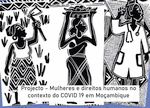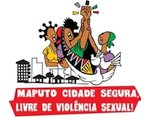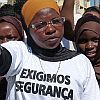Social Identities / Sexual Identities: a Gender Analysis
Conceição Osório
This article is based on a case study done with youth in two secondary schools of Maputo City, with the objective to identify the ways and means used by the cultural model to distinguish and shape masculinity and femininity. Although the sexual dimension has been at the centre of the analysis, the research has taken elements into consideration that, though indirectly related to sexuality, may provide a key to the explanation of the continuation of gender inequality. We refer, for example, to the distribution of domestic work, the cohabitation norms in the family and at school and the mechanisms of removing pregnant girls from school.
Although a series of elements exogenous to the sexual/biological dimension intervene in shaping social identities, this dimension appears as a referent, allowing its construction to be a process that goes on during the whole life cycle. In this process, the roles and functions that people are assuming/ acquiring, the components referring to sexuality are determinants for the social integration of the actors.
This integration occurs through sharing and adhering to values that constitute the basis of the social model. As this is organized and structured by the sexual difference, it is from here that the inequality between men and women is worked out and naturalised. As history amply shows, although male domination is materialised through multiple instruments and means of reference, the body and the anatomic differences between human beings are the cultural text that expresses, by excellence, the model which makes the experiences and lives of women subordinate (Foucault, 1987).
Foucault’s studies focus on the analysis of sexuality through “the knowledge produced about it, the power systems that regulate its practice and how individuals may and should recognise themselves as subjects of this sexuality” (Foucault, 1986: 8) and question the static vision of the phenomenon, allowing the opening up of a line of research which confers a central role to sexuality for the understanding of identities. This approach, laying bare systems of domination previously hidden by the naturalist conception of social organisation, namely of reproduction, not only relates such diverse fields as the political, the cultural and the economic, but also revolutionizes the theories of power. This becomes a constitutive element of the spaces where norms and practices of social control are produced which, aiming at the maintenance of order or the positive appropriation of disorders, have in sexuality a central dimension (Foucault, 1986).
In the current context of the struggle for sexual and reproductive rights, it is interesting to highlight the appearance of new control mechanisms of female sexuality in contemporary societies. For example, in Mozambique, if in rural societies the relation between sexuality and reproduction (the absence of sexual intercourse during breast feeding presupposes the negation of sexuality of the woman as a subject) is still evident, in urban areas the maternal function of the female body assumes great symbolic value: as having more possibilities of power over their own body, through birth control, family planning or through clandestine abortion, women should theoretically no longer be conditioned by a life cycle which constrains them to maternity. However, this continues being the central attribute of female identity.
The issue of the legitimisation of the practice of sexuality through maternity (which gives social utility to the female body) refers us once more to the material and symbolic importance of fertility as factor of social reproduction, a social reproduction materialized by the power exerted on and by the body of women: the silence about sexuality reveals, in fact, a deafening noise about gender domination. For example, in the case of Mozambique, fertility/infertility are criteria that classify not only a situation of biological order but also constitute a fundamental element of how power is exercised. Around this binomial (fertility/infertility) a discourse of sanctions and permissions is produced (after their menopause women are allowed to talk about/transmit “sexualised” knowledge), revealing a representation in which women are denied, outside the context allowed by the cultural model, the practice of sexuality.
It is from this point of view, in which sexuality articulates with power, that it is stated that the body of women is a mirror in which the elements of domination are inscribed, but also those against domination, insofar as “the body of women is a subjected body, because if the subordinate condition is rooted in their own bodies (bodies for the other), it is in them and in their sexuality that the nucleus of their powers reside” (Lagarde, 1997: 11).
Family(ies): learned and appropriated values
Returning to the results of the research, the first issue we are confronted with is that, with respect to socialization in the family, there is, as common sense (regarding “family values”) recognises, no knowledge that allows a clear definition of the parents’ expectations regarding “good behaviour” of the youth. It means that there is, as established by an analysis of the interviews, cohabitation of the so-called traditional values transmitted by/in the families with the appearance of new attributes that simultaneously classify, guide and control the youth. Is became evident that, contrary to what we had expected and what other studies indicated (WLSA, 1998), the factors of modernity not only influenced the contraction of the families (both in terms of their material organisation and of their symbolic representation), but also allowed the appearance of new forms, as is the case of monoparent families or families constituted by uncles, in-laws and cousins. Thus, today we can neither speak of extended families (as these include a variety of links and relations that escape the logic of traditional family groups) nor of families of parents and children. From this situation follow two consequences: first that the inexistence of fixed hierarchisations, which finds a correspondence in a certain precariousness of the social relations in the family, will allow the erosion of old models of reference. The second consequence is that this instability favours, on the one hand, the youth’s search for and insertion into other ways of belonging and, on the other hand, characterizes the identity construction processes as a “fugacity of the sedimentation of identity” (Laire, 2001:5).
The second issue has to do with how in the instability of values and lessons, the social gender relations in the family are organized, that means, if the structure of male domination is also shaken by the destructuring of values, which are the possibilities of rupture with the old mechanisms of subordination of the girls, which the elements that remain or gain new contours and finally which elements may indicate new models of socialization. Therefore, and in the presence of a variety of family forms, and this is valid for the female youth (the older and the younger ones) of the two schools, which are the mechanisms of family socialization and how do they impose themselves and are acquired by the girls?
As has already been stated, in this study, and considering the impossibility to establish generalizations, we took the family and the school as units and the division of labour, (and the “gender culture” revealed by it) and the construction of sexuality as dimensions. Through these units and dimensions we sought to discover, in the material means used as well as in their symbolic implications, the construction of identities guided by sex and constructed by gender.
Regarding the division of labour in the domestic space we found three tendencies: one, a minority, corresponding to an urban reality in a context of more prestigious public schools, where one finds families with greater economic capacity, in which paid domestic servants replace the family members in doing domestic work. A second tendency in which the division of labour is shared, in certain conditions, by the two sexes, and a third (older girls of grades 8 and 10) in which the main domestic activities are carried out by the girls. In this tendency, the naturalization of the division of labour on the part of the girls is supported by a paternal discourse that, while conveying a traditional representation of the roles of men and women, deprives the girls from the responsibility for their life and from the control of decisions. This is demonstrated in the differences in the idea of liberty for daughters and for sons. For the majority of families, though using arguments of an opposite sign, the girls continue to embody fragility, not only derived from their physical vulnerability but mainly from a representation of women as more uncontrolled and susceptible to external influences. This situation is aggravated when the girls witness or witnessed acts of violence systematically inflicted on their mothers. In these cases, without having psychological defence strategies, the girls suffer for their mothers, suffer because they don’t understand, suffer because of impotence, in a play in which they learn the revolt, but also the shame and the “unavoidability” of their condition: “my mother was doing an examination in the examination room, my father arrived and did not let her finish the exam, it was very sad, he went to the examination room. (…) I don’t know why. (…) He also hit her, hit her a lot at night, kicked her and I, I heard it” (grade 8, 12 years).
In the context in which they all work at home, the perceptions on the domestic tasks carried out by boys vary. If for some girls the equal division of labour is normal, for others sharing work is often object of culpabilization on the part of the girls who see the domestic work done by boys as aid and a favour. The effectiveness of this model is even more surprising if we take into account that we are referring to youngsters who attend the second cycle of secondary education and are exposed to a series of values transmitted by the most diverse sources. And one can suppose that the families appreciate the girls’ progress at school.
The sexual division of domestic work is not only a way of socialization of boys and girls in inequality, but it also shapes, from a very early age, the social roles of women and men, “organizing” more ample and profound forms of discrimination, from what one eats (chicken leg) to what one is allowed to do. The symbolic load that the division of labour contains is intergenerational and projects in fact a sense of identity for boys and girls. In a process of imitation of the mothers, aunts and grandmothers, the girls learn, on the one hand, to respond to expectations but, on the other hand, the exposure to and inclusion in other environments of belonging and reference allows them to renew their identities. This phenomenon is also related to the context of modernity, which leads adults to project onto themselves a more permissive image. While the fluidity in the construction of identities of the youth is common to girls and boys, it is certain that the conflicts lived by the girls between socialization structures and models are infinitely large.
With respect to learning about the body, we took as starting point that sexuality not only informs about social relations, but that sexuality itself results from a social structuring guided by an unequal distribution of power between women and men. For this reason gender is the social sex, that means, it is the sex in its relation with itself and with the others. In the study we did we established that during the first few years of life and up to adolescence the socialization process is gradually “sexualising” the body, in the sense that the value that is attributed to it and the control that is exerted on it are realized as a function of a norm in conformity with the social model. It is the case, for example, of the already analysed division of domestic work and of the construction of domesticity.
According to the majority of the interviewed girls, sexuality as representation and practice, is present in the family through silences, suggestive rumours, voices that that suddenly become silent and through the media which invade and sometimes disturb the silences. Belonging to the field of the not-talked-about, sex with its cultural and social attributes transforms itself from the first infantile verbalizations into mechanisms that standardise thought and behaviours. It means that sexuality, though not the only dimension of identity, is the one that better allows us to understand the mechanisms that transform males and females into men and women.
In the case of our study, the ignorance and fear shown by many girls (particularly the older ones) at their first menstruation may be explained by the absence of articulation of the knowledge transmitted at school (we recall that we are talking about girls between grade 8 and grade 10) about the anatomy and physiology of the body with their reality and experience. This situation not only reveals ignorance, but also and mainly a conception that ignorance is a value, a requirement and an attribute of exemplary girls. A girl who knows too much and knows too much about the central nucleus of her identity is a threat for the established order and for its agents entrusted with its control. It is in this sense that the stereotypes constructed about current sexual behaviour of girls in Mozambique are explained and that the girls develop strategies for hiding their affections and desires. The norm about sexuality is supported by beliefs (“not eating eggs”, not drinking from the same cup as the boys”, “not letting patting on the back”) that aim at submitting female sexuality: the exclusion of listening to “serious” conversations among girls who have already gone through the rites of passage to adult age shows the construction of a sexual ethics based on the preservation (as guardian) of the girl for the other. This means that female sexuality, while non-existent in itself, is however a field where social domination is being disputed, manipulated and legitimised. The advice transmitted by some mothers to “be careful with women who have not yet menstruated because they will say that you are ready. (…) It is better to stay away from them” (grade 10, 17 years) seals, in fact, maternity (in the wider sense of service) as female destination. Related to this aspect is the notion of virginity, which though little commented on in the research, appears also as underlying the construction of femininity.
What becomes clear in the first place when analysing the construction of female sexuality in the family is the impossibility to make generalizations. While it was common in the previous generation (due to the economic situation of the parents or to the distances between home and the secondary schools) for families in Maputo City to admit young relatives, this fact did not lead to the current level of violence, for the families of origin, as well as for the new ones (and mainly for the youth), given that the behavioural patterns were sufficiently defined and clarified. Today, the families undergo a process of recomposition and structuring, originating from the constitution of new forms of union and from the exchanges/reciprocities between people, with the result that the appropriation and construction of juvenile identities is done in a process of permanent ruptures and confrontations between the exposure to very contentious values and practices.
If we project this reflection to sexuality, the difficulties to identify the changes occurred, the factors and the nature of these changes and their effect on the construction of new sexualities become evident. What we are trying to show is that the appearance of signs of alteration of juvenile identities combines, often in an apparently incoherent way, with the body control mechanisms arising from the previous model. Using the terminology of the Kuhnian theory of knowledge, we would say that we find ourselves in the field of the “extraordinary”, in the sense that the old, while remaining the dominant paradigm, is confronted with new proposals of looking at and living the world.1
The school as a place of disorder?
With respect to the compatibilization with learning at school, we depart from the assumption that the school, while reproducing the social order, is also a producer of values and norms that, acting on each one of its members, transmits new socialization patterns. Learning does not only distinguish itself because of its contents, rituals and discipline and forms of specific hierarchisation, but also projects conflicts onto other environments of belonging, such as the family. That means, at school the mechanisms that prepare a child for adult life are guided by cultural codes that mould his or her identities. In relation to the family the school reflects but also constructs reality in a logic of complementarity, but also of confrontation, in which new elements of social cohesion replace or coexist with those transmitted by other environments.
In this study, we tried to analyse the appropriation done by girl students of the cultural codes of the school, namely, the construction of new perceptions on sexuality, through information/knowledge acquired in the classroom, in groups of friends and in juvenile associations active at schools. The violence produced in the school environment, and the representations of guilt and sanctions were also given special attention, because of what they may reveal of social anomy, on the one hand, or/and of new forms of shaping male power, on the other hand.
We would like to observe, in the first place, that although apparently age and having good marks do not seem to be important variables for the construction of girls’ discourses about the lessons transmitted in the family, there is among the younger girls (12 years, enrolled in grade 8), a lot of contestation of family values and an intense search for insertion, at least through their discourses, in the groups formed at or outside school: “I’m talking with my friends about how to avoid pregnancy and even in church they talk about it. (…) They not only say that I shouldn’t get involved with men” (grade 9, 13 years). The dialogue “about all topics” with some teachers and mainly with youths of the same age group contributes to the creation of new elements of cohesion, reflected in preferences for the same clothes, music and language. However, the learning about sexuality, apparently done with greater liberty, continues being guided by the arrangements that integrate the roles of women. It became clear, for example, that the only objective of the use of condoms is to avoid pregnancy. Few references were made to the practice of sexuality. This may mean the existence of a negative representation of girls who dare to speak about sex, without reducing it to its reproductive role. The girls refer that using or not using condoms is almost always associated with the agreement with partners and with non-permanent relations, but in any of these cases there are few girls who state having capacity and, mainly (want to have) capacity for negotiation. On the other hand, knowledge about contraception, which could be taught in the lessons about human reproduction in the subject of Biology, is completely silenced. The teachers refer to the reproduction of the fauna and the flora, but regarding the human body they limit themselves to the transmission of technical and dry knowledge.
This means that if the school is for all the girl students a place of opportunities to be “somebody”, to have a profession and work, in terms of curricular contents and of the teacher-student relation, its action on shaping identities is very ambiguous. While the contents, the forms of school hierarchisation and other rituals just by themselves question the organisational forms of roles in the family, the knowledge transmitted and the agents of school learning do not appear as mediators of identity change. In part this situation is due to the precariousness of the situation of the teachers, but mainly to the fact of different forms of socialization being in conflict. The void and the tensions caused by the cohabitation between contradictory aims and functions of the various environments of belonging lead to a certain anomy, which may find expression in authoritarian actions of the teachers as well as in indifference regarding the learning and education of the youth.
The complacency on the part of the educational institution with sexual harassment and blackmail of girl students can be seen as an example of the loss of purpose of the school as an institution that fulfils a social order, but should also be analysed as social deregulation as it attributes in an extraordinary violent and anomic way, “utility” to the body of girls. It should be observed, however, that some youth associations composed of students and teachers make an effort to introduce, though without much success because of the indifference of the school boards, a debate about social relations between youths, sexuality and the involvement of youths in school life. The effectiveness of these actions, recognised as being positive by the interviewed girls, has been limited due to lack of planning and financing. Through the work done in the two secondary schools of Maputo City, it was established that the authorities in charge consider these activities as being extracurricular, not only in the sense of time and spaces of their implementation, but only as an occupation of leisure. This causes a hierarchisation of knowledge and behaviours only in function of strictly instructional norms, clearly not contributing to an education for life.
Regarding the violence produced at school, the girl students identified as main forms of violence, sexual violence and insults addressed to their condition of women: “cow is a serious insult because a cow is a girl who surrenders to her boyfriends, does different things” (grade 8, 12 years). Physical violence between boyfriends is, somehow, justified by jealousy or because the girl has several partners, or because she doesn’t want to have sexual relations, implicitly holding the girl responsible for this situation. The implicit agreement with violence shows some conformity, on the part of he girls, with the social roles that conform a woman to male “property” and to the notion of an uncontrolled male virility. In this order of ideas an important number of youths associates the violation of girls with their way of dressing: “they use short clothes. (…) They also provoke. (…) Men are not made of iron” (grade 9, 14 years) and: “what is more fashionable today are txuma baybe trousers2, short skirts and short blouses, therefore the men become more anxious to catch them” (grade 8, 13 years). These same arguments are used when the interviewed girls were asked about sexual violation among boyfriends: “I think that a woman is only violated when she wants it. (…) When she is being forced, there are others who consent. (…) And then they call this violation, but she is part of this violation. (…) It should be like in South Africa, that when a woman is poorly dressed and she is violated, she is the one in fault” (grade 9, 14 years). The issue of fashion was object of a lot of discussion on the part of the girls, having most of them given the opinion that although people should not be classified on the basis of their clothes, there should an imposition of limits by the environments and the people who accompany them. It is interesting to note that the way of dressing (“almost without clothes”), while clearly being a way of identification with the “new tribes” (Maffesoli, 1995) is also represented by the girls, possibly due to social disapproval, as a transgression.
Sexual violence practised by teachers and expressed in harassment and violation has to do with the social invisibility of female sexuality which allows putting blame and the silencing of the victims and the impunity of the abusers. Giving many examples the interviewed girls said they knew cases of girl students who had been subjected to sexual harassment, and some of them had become pregnant. It is interesting to observe, on the one hand, the “ignorance” of the families and the teachers about cases of sexual harassment (when there is no pregnancy) and, on the other hand, the existence of a lengthy and detailed discourse about cases of sexual violence: “there is a teacher who immediately said I don’t want any money. (…) I want something else you have” (grade 8, 13 years). In the same way, the girls identified cases of failed attempts of harassment, which after having been denounced to the school boards continue covered up, thus allowing the continuation of impunity. But the majority of the girls did not dare to present complaints, for fear and because harassment is a long and continuous process and in itself very violent. Considering the number of cases of harassment by teachers, often accompanied by persecution outside school and by physical violence and violation, the intervention of the education authorities is too timid and complacent. Putting the emphasis on the fight against corruption with money, the sector belittles, even if only symbolically, sexual blackmail and gender violence. The lack of institutional intervention in the punishment of the transgressors follows the idea of the normality of the harassment of women by men and once more strengthens and shapes male power. The reasoning that accusations are necessary to act means in fact connivance with the abuse committed and encourages the continuation of discrimination, strengthening the idea of the school as a place of “danger” for women, not because it teaches the knowledge of equality, but because it marks their destination of submission.
It is possible to speak about change?
Finally we would like to mention some elements of change in the construction of juvenile identities. The cultural complexity that finds expression nowadays in Mozambique, in a multitude of contradictory references, does not allow an explicit identification of the adhesion of the youth to cohesive sets of values and practices. The discourses express the contradictions between environments and agents of socialization, varying between conformity with the education that traditionally is transmitted in the families and revolt and contestation revealed in the discourses among equals (in terms of age and condition). If this is a process that has always been marked by a fluidity characteristic of the construction of juvenile identities, the occurrence of new phenomena in modernity allows us, when talking about the transitoriness to adulthood, the relation between new and old patterns takes on a much more diffused character for the youth.
Regarding the future, the majority of the girls show being independent, hard working and courageous, and the majority projecting themselves in the negation of family values. The girls, even when they say they identify with their mothers, it is always having in mind to overcome the difficulties they are facing, namely conjugal violence and economic dependence. On the other hand, the large majority of the interviewed girls, though viewing maternity as the end of the road towards success, rejects the current family model and proposes a sharing of labour and responsibilities with the partner. The relation with the children is however the structure of change: dialogue and exchange of experiences appear as the key of the ideal family, in opposition to authoritarianism, which is held responsible for the “vulnerability” to the sexual abuse and violence committed at school.
The reference made by the interviewed girls to changes in the structure and elements of family cohesion, namely in the division of labour, in the possibility to choose and in greater liberty, has contributed, on the one hand, to decrease the levels of conflict and, on the other hand, to settle self-esteem and increase the capacity to take possession of, without violent ruptures, the mechanisms of adhesion to new groups. On the other hand, the importance attributed by some parents to the continuation of their studies, evident in their concern about school results and about the time available for it (at the expense of domestic work), is associated by the girls less with rights than with affability of the adults. One of the reasons found for this situation continues to be the ambiguity existing between differentiated socializations and the dominant representation of woman as non-subjects.
Regarding relations with the boys, some girls (particularly those who are active in sexual and reproductive health associations) question the decision power of their boyfriends over their body and its compensation in goods, that means, a position starts to appear that, although still by a small minority, defends the attainment of equality by the girls themselves, imposing the rules of the game, from not accepting gifts in exchange for sexual favours to refusing sexual relations, irrespective of the use of condoms. It is interesting that the issue of gifts from boyfriends (even of approximately the same age) appears repeatedly in all discourses, and is always (although accepted practice by some boys and girls) negatively represented. Interestingly and related to the adhesion to juvenile fashion (which is a mechanism of inclusion into the youth group) arises an idea that the use of “indecent” clothes is a feminine seduction strategy rooted in the representation of the negotiation of the body as an object.
Marriage, although considered a desirable target and appearing as the result of a certain social compensation for the “good” behaviour of girls (with its procession of children, a house and goods), is also object of a new idea: “I want to be independent. I want to marry but I want to be different. (…) My aunt now earns a lot of money but she commands her husband. (…) She maintains the house and commands. (…) But not me, I want that my husband is part of the house. (…) But I also don’t want to depend on him” (grade 8, 16 years). It is curious to note that this new perception of marriage corresponds to an ideal of life, which has economic independence as its core element, in opposition to the situation of women of the girls’ families, where almost always the lack of access to goods is the decisive factor in the organisation of family power. Through the influence of the school which individualizes the girls (even if in a violent way) and possibly also due to the soap operas (the characters of which are classified according to their capacity to act on adverse realities), the youths incorporate into their identities new elements of cohesion. In this order of values and also by contrast with the reality of the family and the reality experienced in the groups of friends, faithfulness in marriage is rooted in dialogue, in honesty and in the recognition of the partner as a person: “I want love. (…) But for me love is respect. (…) If we are dissatisfied with something, we should say so. (…) I think that one does not divide feelings” (grade 8, 15 years).
The movement between spaces, between environments and between agents finds its correspondence in the fluctuation between values and practices, that means, the adhesion to groups is ephemeral and transitory, giving each one of them representations and norms that are constantly being renewed. The appropriation by the youths of new elements in conflict or not with old factors of cohesion, causes the coexistence of contradictory discourses that reveal differentiated interpretations and reinterpretations of life and of the world.
Regarding social gender relations, the exposure to permanent oppositions produced in the environments of belonging, including the confrontation between the individualization offered by the school and the collectivisation by the family, may strengthen the questioning of male domination. What is established in this study is that the change in language, which expresses in fact the rejection of the traditional models of family organisation (work, the value of study), does not allow yet the identification of a normative pattern that changes the deep sense of female subordination and left a series of issues unanswered, that would allow a better identification of the components and mechanisms of aggregation in the various spaces (family, friends, associations, schools and others), emphasizing the elements of rupture that may constitute new tendencies.
- For more information about the work of Thomas Kuhn we recommend, among others: The Structure of Scientific Revolutions.
- Txuma baybe are jean trousers, with a low waist, very tight and cheap. Txuma means to make the girls irresistible.
References:
FOUCAULT, Michel (1986), História da Sexualidade, vol. I.- Rio de Janeiro: Graal.
FOUCAULT, Michel (1987), História da Sexualidade, vol. II.- Lisboa: Gradiva.
HEILBORN, Luísa (1999), Introdução: Ciências sociais e sexualidade.- In: L. Heilborn (org.), Sexualidade.- Rio de Janeiro: Zahar ed. pp. 7-20
LAIRE, Fernando (2001), ¿Identidad Juvenil? La Insoportable Levedad del Ser: Aportes Para Renovar el Marco Teórico de los Estudios sobre Juventud.- In: MAD, nº 4.
LARGADE, Marcela (1997), La sexualidad in Los cautiverios de las mujeres: madreposas, monjas, putas, presa y locas.- México, UNAM. pp.177-211
MAFFESOLI, Michel (1995), Autour d´Anthony Giddens.- In: Sociétés, nº 48. pp 85-120
WLSA MOÇAMBIQUE (1999).- Famílias em contextos de mudanças em Moçambique.- Maputo: WLSA Moçambique.







 Information in English
Information in English



















